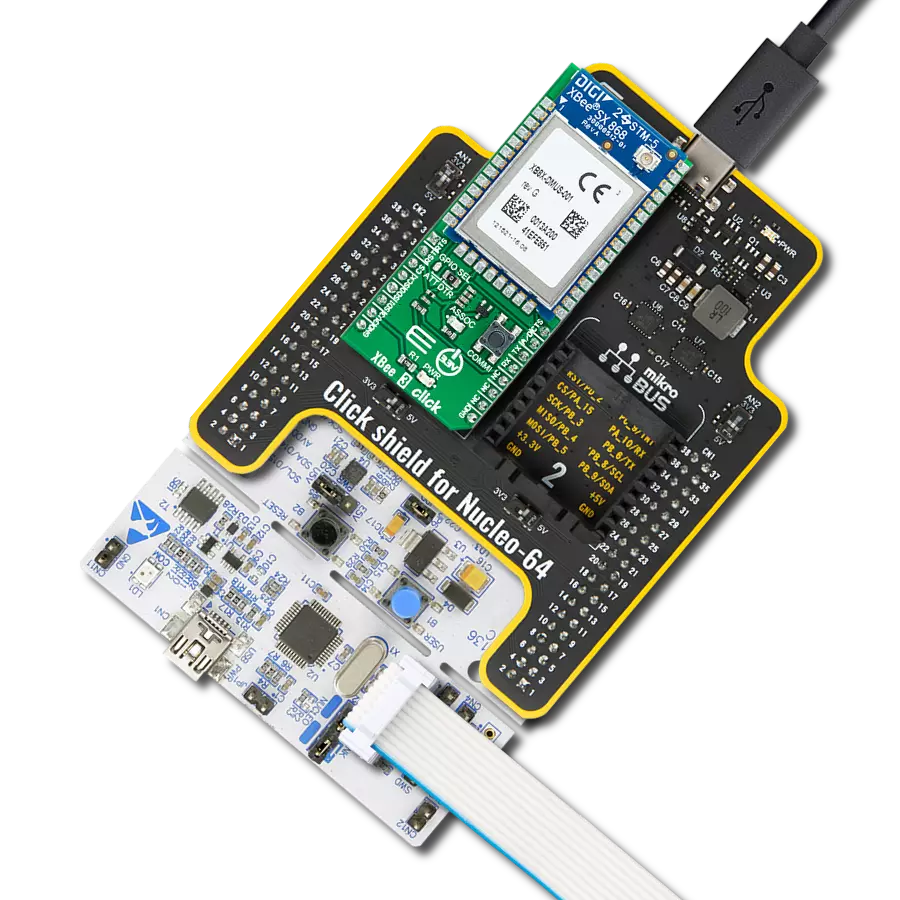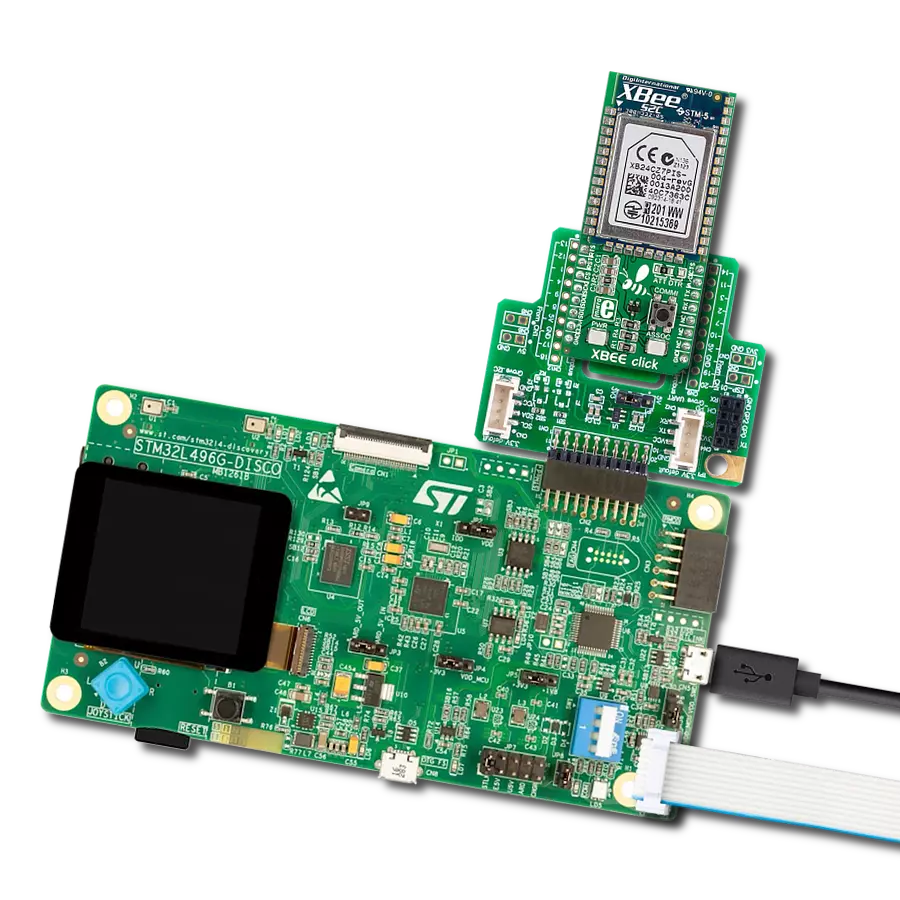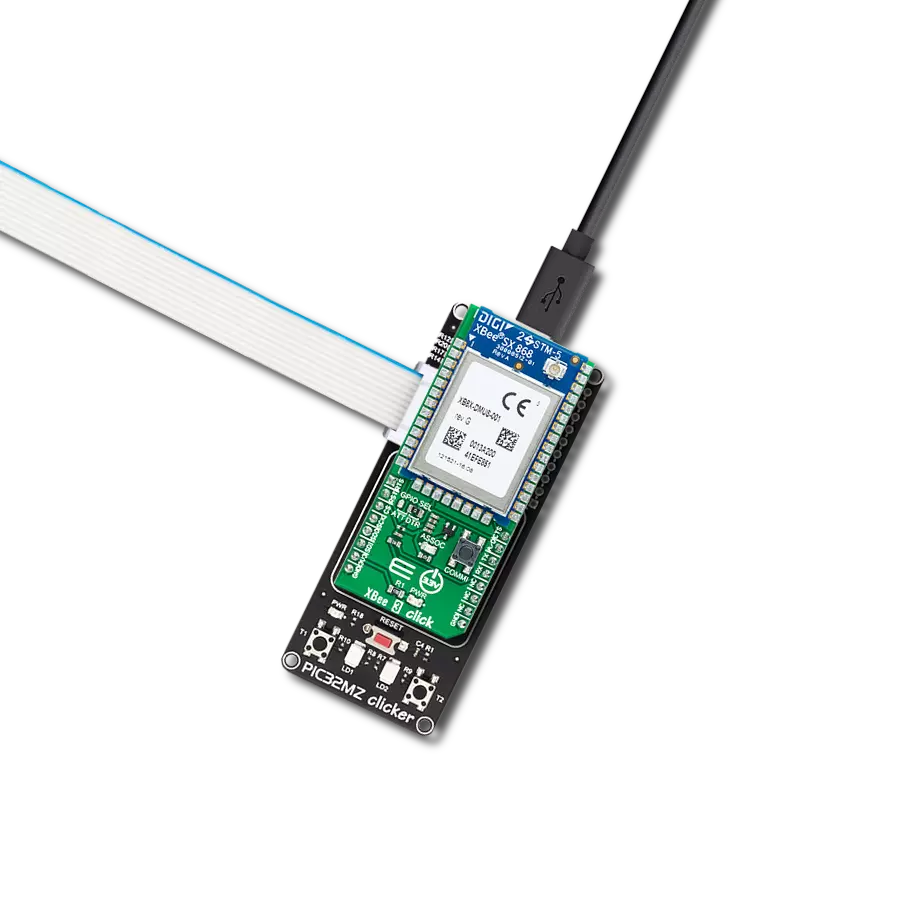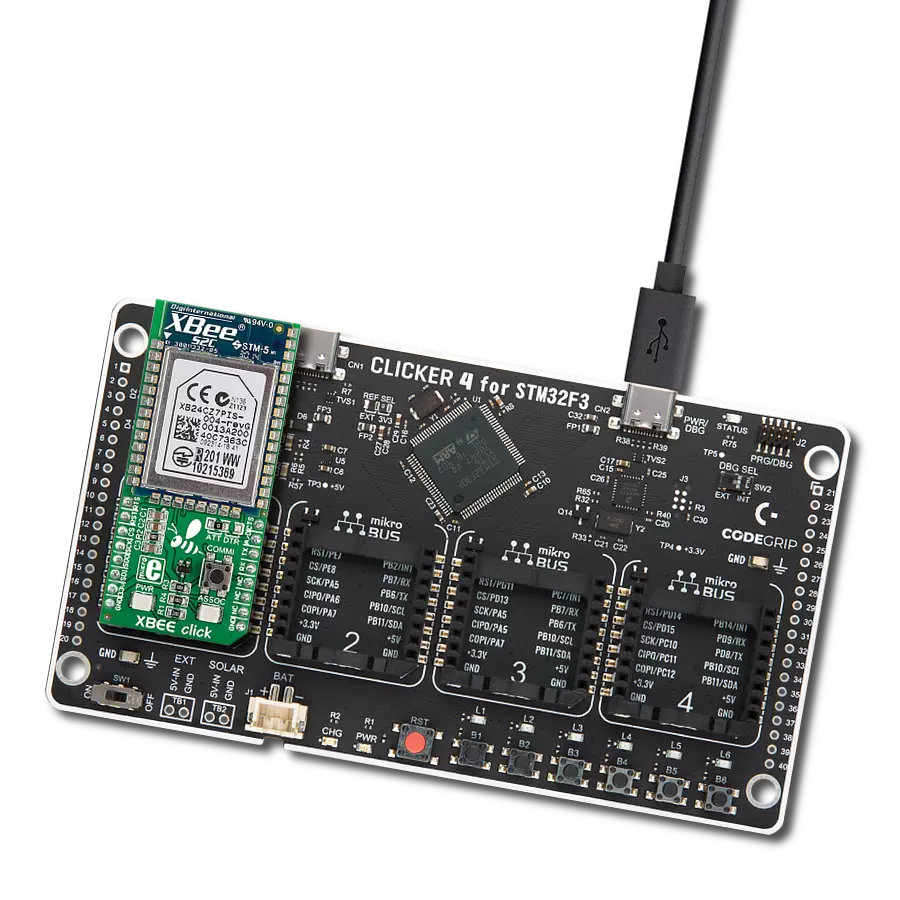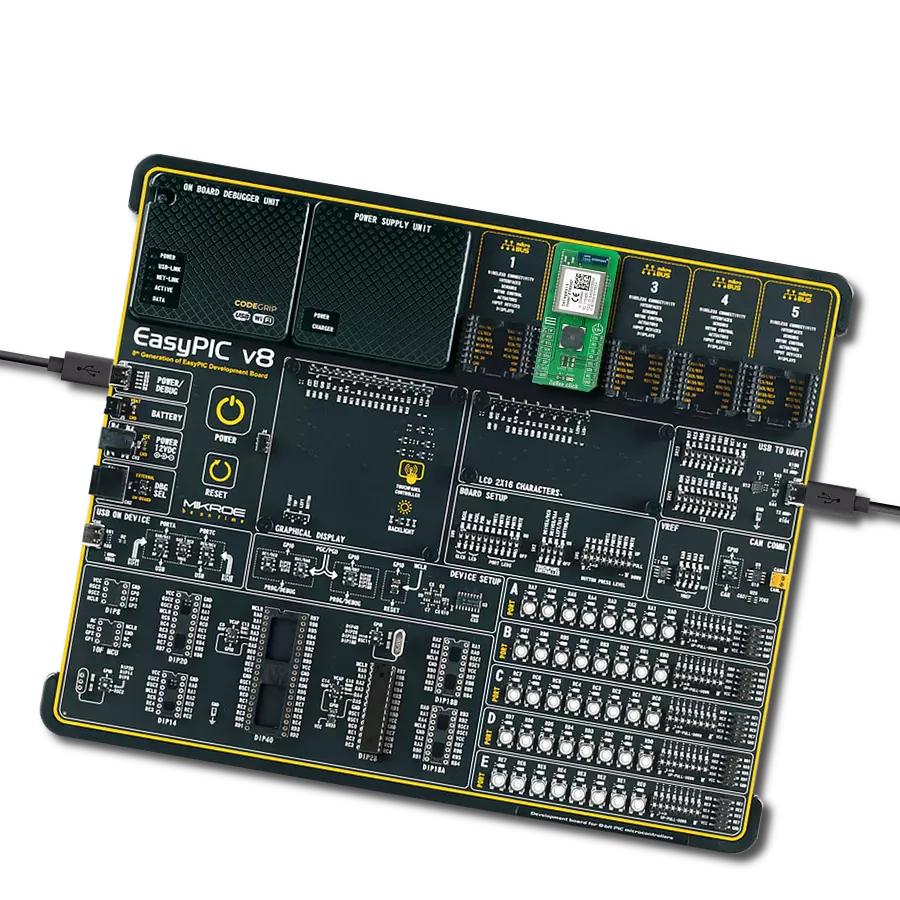探索我们 ZigBee 无线电模块的潜力,该模块精心设计以节省电能,同时提供强大的无线连接,非常适合需要高效和可靠性的物联网应用。
A
A
硬件概览
它是如何工作的?
ZigBee Click 基于 ETRX357,这是一款低功耗 Zigbee 无线电模块,集成了许多先进外设的 2.4 GHz 收发器,由 Silicon Labs 提供。ZigBee 协议是一套用于短到中距离设备间无线连接的标准。它使用 IEEE 802.15.4 无线电规范在 2.4GHz 频段运行,并加上三个额外的网络、安全和应用层。该模块的独特之处在于它使用了网状网络架构,以桶链式将数据从一个节点传递到下一个节点,直到到达目的地。ETRX357 模块预装了一个独立的引导加载程序,支持通过 ZigBee Click 上的 FW 引脚进行空中引导加载和串行引导加载新固件。模块使用由简单 AT 命令组成的默认固件进行控制。定义模块功能并允许独立功能的参数保存在非易失性存储器中,组织在所谓的 S 寄存器中。
命令和响应通过 ETRX357 的串行端口作为 ASCII 文本传递,因此通常只需一个简单的终端应用程序即可。行业标准的串行线、JTAG 编程和调试接口以及标准的 ARM 系统调试组件有助于简化任何自定义软件开发。此外,几个 MAC 功能也在硬件中实现,以帮助保持 ZigBee 和 IEEE802.15.4 标准所施加的严格时间要求。该模块还能够通过外部主机控制充当协调器和信任中心。AT 风格命令行提供了设置和管理 Zigbee 网络所需的所有工具,允许轻松访问堆栈的低级功能。ZigBee Click 使用 UART 接口与 MCU 通信作为其默认通信协议,但也为用户提供了使用其他接口(如 SPI 和 I2C)的选项,如果用户希望配置模块并自行编写库。可以通过将标记为 COMM SEL 的
SMD 跳线定位到适当位置来选择 UART 和 I2C 之间的通信。请注意,所有跳线必须放置在同一侧,否则 Click board™ 可能会无响应。其他功能如复位和中断通过 mikroBUS™ 的 RST 和 INT 引脚提供和路由,串行 UART 连接 CTS 和 RTS 则通过 mikroBUS™ 的 CS 和 PWM 引脚路由。为了简化部署,Click board™ 配备了由 ZigBee 模块控制的 CMT-8540S-SMT 磁性蜂鸣器,用于声音信号和通知。您可以使用我们编译器支持的声音库创建不同的声音模式。信号频率决定声音的音调,占空比决定振幅(音量)。此 Click board™ 设计为仅在 3.3V 逻辑电平下运行。在使用具有不同逻辑电平的 MCU 之前,应进行适当的逻辑电压电平转换。
功能概述
开发板
Nucleo-64 搭载 STM32F410RB MCU 提供了一种经济高效且灵活的平台,供开发者探索新想法并原型设计他们的项目。该板利用 STM32 微控制器的多功能性,使用户能够为他们的项目选择最佳的性能与功耗平衡。它配备了 LQFP64 封装的 STM32 微控制器,并包含了如用户 LED(同时作为 ARDUINO® 信号)、用户和复位按钮,以及 32.768kHz 晶体振荡器用于精确的计时操作等基本组件。Nucleo-64 板设计考虑到扩展性和灵活性,它特有的 ARDUINO® Uno
V3 扩展连接器和 ST morpho 扩展引脚头,提供了对 STM32 I/O 的完全访问,以实现全面的项目整合。电源供应选项灵活,支持 ST-LINK USB VBUS 或外部电源,确保在各种开发环境中的适应性。该板还配备了一个具有 USB 重枚举功能的板载 ST-LINK 调试器/编程器,简化了编程和调试过程。此外,该板设计旨在简化高级开发,它的外部 SMPS 为 Vcore 逻辑供电提供高效支持,支持 USB 设备全速或 USB SNK/UFP 全速,并内置加密功能,提升了项目的功效
和安全性。通过外部 SMPS 实验的专用连接器、 用于 ST-LINK 的 USB 连接器以及 MIPI® 调试连接器,提供了更多的硬件接口和实验可能性。开发者将通过 STM32Cube MCU Package 提供的全面免费软件库和示例得到广泛支持。这些,加上与多种集成开发环境(IDE)的兼容性,包括 IAR Embedded Workbench®、MDK-ARM 和 STM32CubeIDE,确保了流畅且高效的开发体验,使用户能够充分利用 Nucleo-64 板在他们的项目中的能力。
微控制器概述
MCU卡片 / MCU
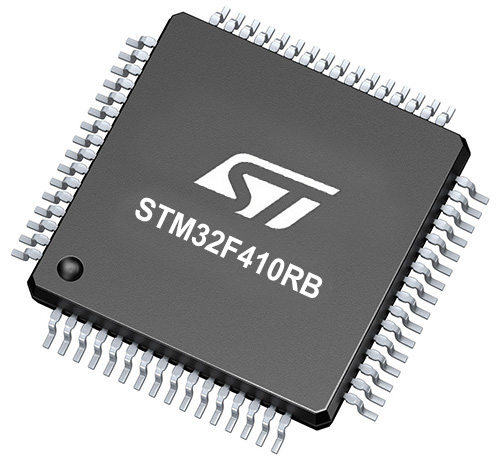
建筑
ARM Cortex-M4
MCU 内存 (KB)
128
硅供应商
STMicroelectronics
引脚数
64
RAM (字节)
32768
你完善了我!
配件
Click Shield for Nucleo-64 配备了两个专有的 mikroBUS™ 插座,使得所有的 Click board™ 设备都可以轻松地与 STM32 Nucleo-64 开发板连接。这样,Mikroe 允许其用户从不断增长的 Click boards™ 范围中添加任何功能,如 WiFi、GSM、GPS、蓝牙、ZigBee、环境传感器、LED、语音识别、电机控制、运动传感器等。您可以使用超过 1537 个 Click boards™,这些 Click boards™ 可以堆叠和集成。STM32 Nucleo-64 开发板基于 64 引脚封装的微控制器,采用 32 位 MCU,配备 ARM Cortex M4 处理器,运行速度为 84MHz,具有 512Kb Flash 和 96KB SRAM,分为两个区域,顶部区域代表 ST-Link/V2 调试器和编程器,而底部区域是一个实际的开发板。通过 USB 连接方便地控制和供电这些板子,以便直接对 Nucleo-64 开发板进行编程和高效调试,其中还需要额外的 USB 线连接到板子上的 USB 迷你接口。大多数 STM32 微控制器引脚都连接到了板子左右边缘的 IO 引脚上,然后连接到两个现有的 mikroBUS™ 插座上。该 Click Shield 还有几个开关,用于选择 mikroBUS™ 插座上模拟信号的逻辑电平和 mikroBUS™ 插座本身的逻辑电压电平。此外,用户还可以通过现有的双向电平转换器,使用任何 Click board™,无论 Click board™ 是否在 3.3V 或 5V 逻辑电压电平下运行。一旦将 STM32 Nucleo-64 开发板与我们的 Click Shield for Nucleo-64 连接,您就可以访问数百个工作于 3.3V 或 5V 逻辑电压电平的 Click boards™。
使用的MCU引脚
mikroBUS™映射器
“仔细看看!”
Click board™ 原理图

一步一步来
项目组装
软件支持
库描述
该库包含 ZigBee Click 驱动程序的 API。
关键功能:
zigbee_send_at- 合并两个字符串并将其发送到设备的功能zigbee_resp- 检查驱动程序缓冲区字符串的功能zigbee_set_pin_rst- 设置 RST 引脚状态的功能
开源
代码示例
完整的应用程序代码和一个现成的项目可以通过NECTO Studio包管理器直接安装到NECTO Studio。 应用程序代码也可以在MIKROE的GitHub账户中找到。
/*!
* @file main.c
* @brief ZigBee Click Example.
*
* # Description
* This is an example that demonstrates the use of the ZigBee Click board.
*
* The demo application is composed of two sections :
*
* ## Application Init
* Initialization of driver, UART ISR and then configures device.
* Depending on previous selected device mode it creates new PAN network or joins to one.
*
* ## Application Task
* Host mode: Broadcasts message 'MikroE' every 3 seconds.
* User mode: Checks if something is received.
*
* ## Additional Function
* - void zigbee_clear_app_buf ( void ) - Clearing application buffer function.
* - void resp_wait ( zigbee_t *ctx ) - Function for waiting for complete response.
*
* @author Stefan Ilic
*
*/
#include "board.h"
#include "log.h"
#include "zigbee.h"
static zigbee_t zigbee;
static log_t logger;
uint8_t dev_mode;
uint8_t app_mode;
static char app_buf[ ZIGBEE_DEV_BUFFER_MAX ] = { 0 };
char AT_BCAST_MSG[ 15 ] = ":00,MikroE";
char AT_HOST_CFG1[ 10 ] = "00=6314";
char AT_HOST_CFG2[ 20 ] = "0A=0914;password";
char AT_HOST_CFG3[ 50 ] = "09=5A6967426565416C6C69616E63653039;password";
/**
* @brief ZigBee clearing application buffer.
* @details This function clears memory of application buffer and reset it's length and counter.
*/
void zigbee_clear_app_buf ( void );
/**
* @brief ZigBee wait response.
* @details This function is used for waiting for complete response.
*/
void resp_wait ( zigbee_t *ctx );
void application_init ( void )
{
log_cfg_t log_cfg; /**< Logger config object. */
zigbee_cfg_t zigbee_cfg; /**< Click config object. */
/**
* Logger initialization.
* Default baud rate: 115200
* Default log level: LOG_LEVEL_DEBUG
* @note If USB_UART_RX and USB_UART_TX
* are defined as HAL_PIN_NC, you will
* need to define them manually for log to work.
* See @b LOG_MAP_USB_UART macro definition for detailed explanation.
*/
LOG_MAP_USB_UART( log_cfg );
log_init( &logger, &log_cfg );
log_info( &logger, " Application Init " );
app_mode = ZIGBEE_APP_INIT;
dev_mode = ZIGBEE_DEV_USER;
// Click initialization.
zigbee_cfg_setup( &zigbee_cfg );
ZIGBEE_MAP_MIKROBUS( zigbee_cfg, MIKROBUS_1 );
if ( UART_ERROR == zigbee_init( &zigbee, &zigbee_cfg ) )
{
log_error( &logger, " Communication init." );
for ( ; ; );
}
log_printf( &logger, "------------------------------\r\n", app_buf );
log_printf( &logger, " Restarting Device \r\n" );
zigbee_restart( &zigbee );
log_printf( &logger, "------------------------------\r\n", app_buf );
log_printf( &logger, " Sending command : AT \r\n", app_buf );
zigbee_send_cmd( &zigbee, ZIGBEE_CMD_AT );
resp_wait( &zigbee );
log_printf( &logger, "------------------------------\r\n", app_buf );
log_printf( &logger, " Sending command : AT + DASSL \r\n", app_buf );
zigbee_send_cmd( &zigbee, ZIGBEE_CMD_AT_DASSL );
resp_wait( &zigbee );
log_printf( &logger, "------------------------------\r\n", app_buf );
log_printf( &logger, " Sending command : ATZ \r\n", app_buf );
zigbee_send_cmd( &zigbee, ZIGBEE_CMD_ATZ );
resp_wait( &zigbee );
log_printf( &logger, "------------------------------\r\n", app_buf );
log_printf( &logger, " Sending command : ATI \r\n", app_buf );
zigbee_send_cmd( &zigbee, ZIGBEE_CMD_ATI );
resp_wait( &zigbee );
log_printf( &logger, "------------------------------\r\n", app_buf );
log_printf( &logger, " Sending command : AT + N \r\n", app_buf );
zigbee_send_cmd( &zigbee, ZIGBEE_CMD_AT_N );
resp_wait( &zigbee );
if ( ZIGBEE_DEV_HOST == dev_mode )
{
// Setting the device into host mode and creating a network for other devices to connect.
log_printf( &logger, "-----------------------------------\r\n", app_buf );
log_printf( &logger, " Sending command : AT + HOST CFG 1 \r\n", app_buf );
zigbee_send_at( &zigbee, ZIGBEE_CMD_ATS, &AT_HOST_CFG1[ 0 ] );
resp_wait( &zigbee );
log_printf( &logger, "-----------------------------------\r\n", app_buf );
log_printf( &logger, " Sending command : AT + HOST CFG 2 \r\n", app_buf );
zigbee_send_at( &zigbee, ZIGBEE_CMD_ATS, &AT_HOST_CFG2[ 0 ] );
resp_wait( &zigbee );
log_printf( &logger, "-----------------------------------\r\n", app_buf );
log_printf( &logger, " Sending command : AT + HOST CFG 3 \r\n", app_buf );
zigbee_send_at( &zigbee, ZIGBEE_CMD_ATS, &AT_HOST_CFG3[ 0 ] );
resp_wait( &zigbee );
log_printf( &logger, "-----------------------------------\r\n", app_buf );
log_printf( &logger, " Sending command : AT + EN \r\n", app_buf );
zigbee_send_cmd( &zigbee, ZIGBEE_CMD_AT_EN );
resp_wait( &zigbee );
}
else if ( ZIGBEE_DEV_USER == dev_mode )
{
// Setting the device into user mode and joining the existing network.
log_printf( &logger, "-----------------------------------\r\n", app_buf );
log_printf( &logger, " Sending command : AT + JN \r\n", app_buf );
zigbee_send_cmd( &zigbee, ZIGBEE_CMD_AT_JN );
resp_wait( &zigbee );
}
log_printf( &logger, "-----------------------------------\r\n", app_buf );
log_printf( &logger, " Sending command : AT + IDREQ \r\n", app_buf );
zigbee_send_cmd( &zigbee, ZIGBEE_CMD_AT_IDREQ );
resp_wait( &zigbee );
log_printf( &logger, "-----------------------------------\r\n", app_buf );
log_printf( &logger, " Sending command : AT + N \r\n", app_buf );
zigbee_send_cmd( &zigbee, ZIGBEE_CMD_AT_N );
resp_wait( &zigbee );
Delay_ms ( 1000 );
app_mode = ZIGBEE_APP_TASK;
log_info( &logger, " Application Task " );
log_printf( &logger, "-----------------------------------\r\n", app_buf );
}
void application_task ( void )
{
if ( ZIGBEE_DEV_HOST == dev_mode )
{
log_printf( &logger, "-----------------------------------\r\n", app_buf );
zigbee_send_at( &zigbee, ZIGBEE_CMD_AT_BCAST, &AT_BCAST_MSG[ 0 ] );
resp_wait( &zigbee );
Delay_ms ( 1000 );
Delay_ms ( 1000 );
Delay_ms ( 1000 );
}
else if ( ZIGBEE_DEV_USER == dev_mode )
{
resp_wait( &zigbee );
log_printf( &logger, "-----------------------------------\r\n", app_buf );
}
}
int main ( void )
{
/* Do not remove this line or clock might not be set correctly. */
#ifdef PREINIT_SUPPORTED
preinit();
#endif
application_init( );
for ( ; ; )
{
application_task( );
}
return 0;
}
void zigbee_clear_app_buf ( void )
{
memset( app_buf, 0, ZIGBEE_DEV_BUFFER_MAX );
}
void resp_wait ( zigbee_t *ctx )
{
uint8_t resp_flag;
for ( ; ; )
{
zigbee_generic_read( &zigbee, app_buf, ZIGBEE_DEV_BUFFER_MAX );
Delay_ms ( 50 );
resp_flag = zigbee_resp( ctx, app_buf );
if ( ( ZIGBEE_APP_TASK == app_mode ) && ( ZIGBEE_DEV_USER == dev_mode ) )
{
if ( ( ZIGBEE_OP_WAIT != resp_flag ) )
{
log_printf( &logger, " %s ", app_buf );
zigbee_clear_app_buf( );
}
}
else
{
if ( ( ZIGBEE_OP_OK == resp_flag ) || ( ZIGBEE_OP_ERROR == resp_flag ) )
{
log_printf( &logger, "%s", app_buf );
log_printf( &logger, "\r\n" );
zigbee_clear_app_buf( );
break;
}
}
}
}
// ------------------------------------------------------------------------ END
额外支持
资源
类别:ZigBee




















